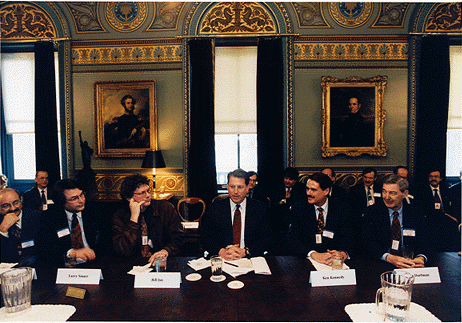
Spring/Summer 1999
Volume 6, Issue 2
Spring/Summer 1998
Volume
3, Issue 1
January 1995
Volume
2, Issue 4
October 1994
Volume
2, Issue 1
January 1994
HPCC Advisory Committee Plans Internet of the Future
The Advisory Committee on High Performance Computing and Communications, Information Technology, and the Next Generation Internet (NGI) recently completed the second of two meetings held this year at the National Science Foundation in Arlington, Virginia. Co-chaired by CRPC Director Ken Kennedy, the 21-member committee was appointed by President Clinton to advise the federal government on the implementation of the High Performance Computing and Communications (HPCC) program and the NGI. The committee will also determine whether the research and development (R&D) funded by these programs is helping to maintain United States leadership in advanced computing. CRPC External Advisory Committee (EAC) members Steven Wallach and David Cooper (see "EAC Focus") are also committee members.
At the first meeting, held February 27-28, committee members developed a two-phase strategy for operation over the next two years. First, they initiated a fast-turn review of the proposed federal NGI initiative. After the review, they released a report in May concluding that the NGI program will provide great intellectual, social, and economic benefits to the nation. The report identified important conditions for achieving successful implementation, such as the need for substantive matching investments by the government for campus network upgrades, digitial libraries, and health care system networks. The report also recommended closer coordination between the NGI Initiative and the academic community's complementary program, Internet 2.
 |
|
| Photography by Phil Humnicky, The White House | |
"In carrying out the evaluation, our principal strategy is to look forward a decade to envision what the world of communications and computing would be like if the program goals are met," says Kennedy. "Then we'll work backward to today's activities to ensure that the right steps are being taken. If there are problems that need to be addressed or oversights that need to be remedied, we will work with the agencies to seek corrections or speak out in reports and recommendations to the Office of Science and Technology Policy."
The second meeting, held June 24-25, addressed networking R&D directions and high-end computing strategies, and formed subcommittees to handle various tasks. The NGI continues to be a top priority, and the committee discussed the initiative's plans to conduct research on networking issues like quality of service, reliability, and security. The initiative would also build an experimental testbed interconnecting the nation's best R&D institutions, using new applications that are expected to make the transition to an enhanced commercial Internet.
For more information about the Advisory Committee and the meetings, see http://www.itrd.gov/pubs/blue98/advisory_committee.html.
For a complete list of members and their affiliations, see http://www.itrd.gov/pubs/blue95/section.2.9.html
Table of Contents